Fried halloumi bowls over bright and lemony quinoa with roasted beets and sautéed garlicky rainbow chard, then topped with pickled red onions, tzatziki, pomegranate arils, and mint. With pre-roasted beets and store-bought tzatziki, this is our go-to quick weeknight dinner that tastes like it took hours! Got picky eaters? serve components separately!
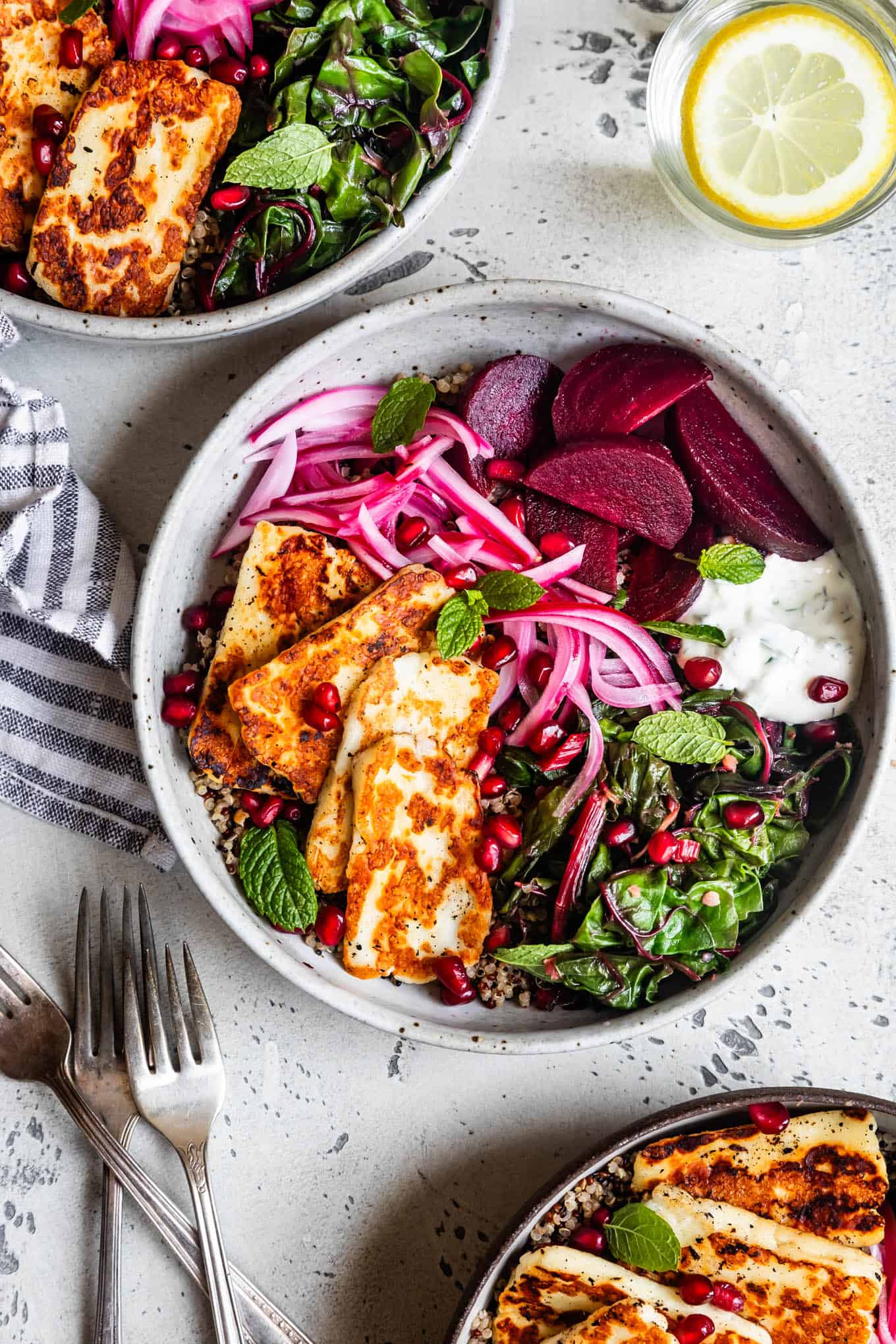
This post is sponsored by Andronico's Community Markets, a year-long partner of Snixy Kitchen, but the opinions are all my own.
Do you ever wonder what other people like you eat for dinner every night? I genuinely want to know - please make me a list when you introduce yourself. If you were to ask me for a list of our go-to weeknight family dinners, this fried halloumi over quinoa veggie bowls would make the cut. AND it'd also be highlighted in green to denote all-time favorite recipes in regular rotation.
I know because I made that spreadsheet and shared it with every parent I knew hoping they'd add to it and we could compile a huge list of family-friendly recipes. That project is a work in progress...
After making them enough times, I decided these fried halloumi quinoa bowls are too delicious to live just on a spreadsheet. Garlicky sumac quinoa topped with crisp golden brown halloumi, quick pickled onions, sautéed garlic chard, and roasted beets, then garnished with tzatziki, pomegranate arils, and fresh mint. Together, these bowls are all at once savory, sweet, sour, salty, and bright, with chewy cheesy goodness. Packed with unique umami flavor, halloumi is one of my favorite proteins to throw on bowls or in tacos.
I'm partnering with Andronico's Community Markets, to share all about halloumi and one of my current favorite ways to serve it!

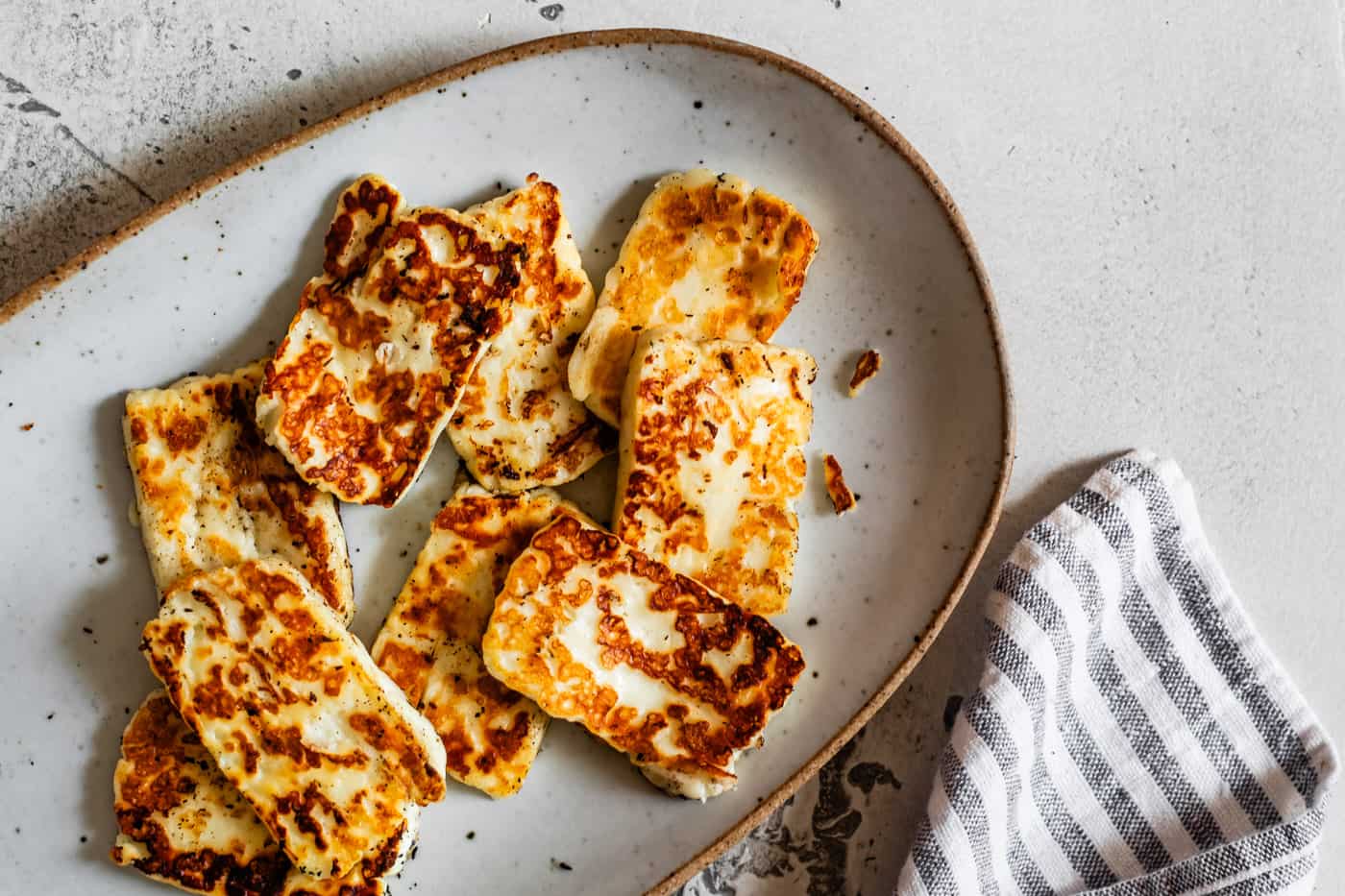
What is halloumi?
Originating from Cyprus, halloumi is a firm unripened white cheese made of sheep's and/or goat's milk and sometimes cow's milk. It looks similar to a mozzarella log in the store, but the texture is something entirely different.
When eaten raw, the texture is very squeaky, reminiscent of cheese curds, but this is not the most common way to eat halloumi. The real magic happens when it's cooked. As a sturdy cheese with a high melting point, it's ideal for frying, grilling, or baking. When cooked, halloumi retains its shape, but the texture becomes soft and chewy with a crisp golden-brown exterior.
Halloumi is used extensively in Mediterranean cooking and is widely available throughout the United States.
What does halloumi cheese taste like?
The flavor of halloumi is unmatched by any other cheese. With a mellow flavor, halloumi is notably salty and tangy thanks to the brine. When fried, the crispy golden brown bits give way to a soft and chewy center. Imagine the crispy cheese bits on a pizza, but less greasy and with an even better texture.
When added to any dish, halloumi becomes the protein star of the show. Fried cheese for the win!
Where to buy halloumi? Andronico's Community Market
With the popularity of halloumi, it's fairly easy to find at grocery stores in the US.
Bay Area folks: I get mine at my local Andronico's Community Market, where I also picked up everything I need for this recipe - from Boar's Head tzatziki to pomegranate arils. I love that Andronico's carries a wide range of products, including two different brands of halloumi and super high-quality produce. It's my go-to one-stop grocery store.
Here's a list of all the recipes I've made in partnership with Andronico's this past year and a half.



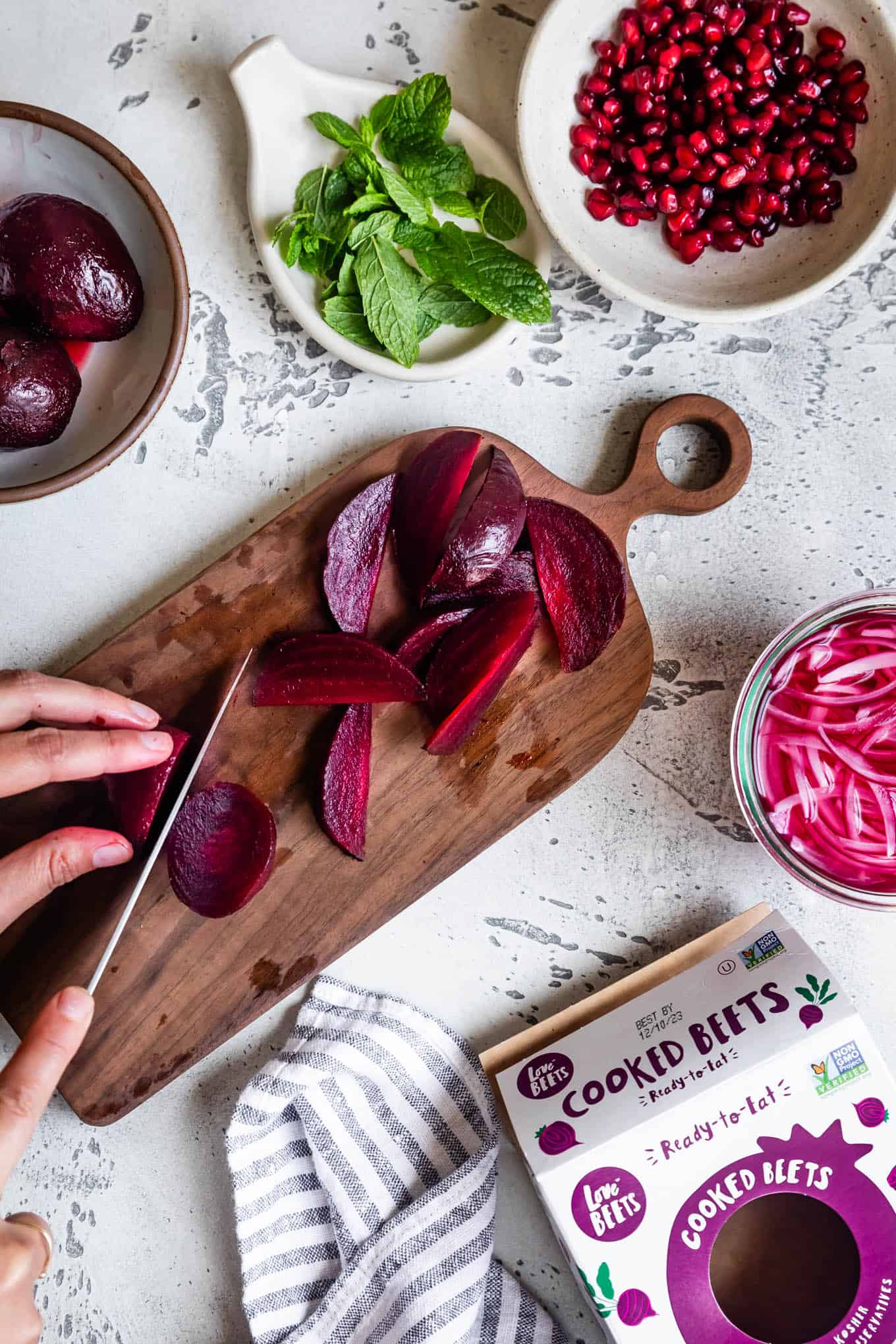
Ingredients for Halloumi over Quinoa Veggie Bowls
These halloumi bowls over quinoa with beets and chard have entered our regular meal-planning rotation. With pre-roasted beets and store-bought tzatziki, it's a quick weeknight dinner that tastes like it took hours. Here are all the ingredients you'll need, but feel free to use this as a jumping-off point and sub in whatever veggies you love or have on hand!
- Quinoa: Create flavorful quinoa by cooking white, red, or rainbow quinoa with plenty of fresh garlic and vegetable broth. For these bowls, I add sumac to the quinoa then finish with a squeeze of fresh lemon. Sumac adds flavor depth to the quinoa that is smoky, tangy, and sour with a hint of citrus and is one of my pantry staples.
- Quick pickled red onion: Quick pickled red onions take about 2 minutes to make, and add so much to your dish. Use white wine vinegar, or sub with white vinegar, rice vinegar, apple cider vinegar, and red wine vinegar.
- Chard or kale: Use whatever greens you love most: rainbow chard, lacinato kale, spinach, or other leafy greens. Give them a quick sauté in a drizzle of olive oil with fresh garlic until wilted.
- Halloumi: Slice the halloumi into scant ¼-inch thick pieces.
- Cooked peeled beets: If you've got time, you can roast your own beets. To save time, I use store-bought Love Beets cooked and peeled organic beets, and heat them up to serve. They taste just like freshly roasted beets! You can find these (and other similar brands) in the refrigerator in the produce aisle of the grocery store.
- Tzatziki: This Greek yogurt dip is the sauce for this bowl. Store-bought Boar's Head tzatziki greek yogurt dip is great for super quick dinners, but if you can't find any pre-made or you have the extra time, tzatziki is super easy to make at home. Recipe below!
- Pomegranate arils: Pomegranate arils add a pop of brightness to the bowls that I personally love. They're not available year-round, so when I can't find them, I just skip this garnish.
- Fresh mint: Fresh mint adds to the brightness, making each bite just a bit more exciting. You could also sub in fresh dill!


Make ahead weeknight halloumi quinoa bowls
All the components can be made up to 3 days in advance and stored separately in an airtight container in the fridge. For example, prepare the quinoa, quick pickled red onions, and chard in advance and your dinner will come together in less than 10 minutes.
Halloumi is best served freshly fried, so I recommend saving that step until you're ready to eat. However, you can also store fried halloumi and reheat it in the microwave for 20-30 seconds and it's still very delicious.
Family-friendly halloumi quinoa bowls
Got picky eaters? I've got two. Halloumi is one of my kids' all-time favorite foods, so we make these bowls regularly but serve everything separately for the kids. We give them a plate with halloumi, pomegranate arils, and cooked greens, and a bowl of quinoa on the side. If I'm making the tzatziki from scratch, I also give them some raw cucumber slices. Especially if your picky eaters won't eat cooked greens, cucumber slices are a great option!
I also give them a beet slice and a spoonful of tzatziki, but I'll be honest, they haven't eaten those two yet. But not for lack of opportunity!
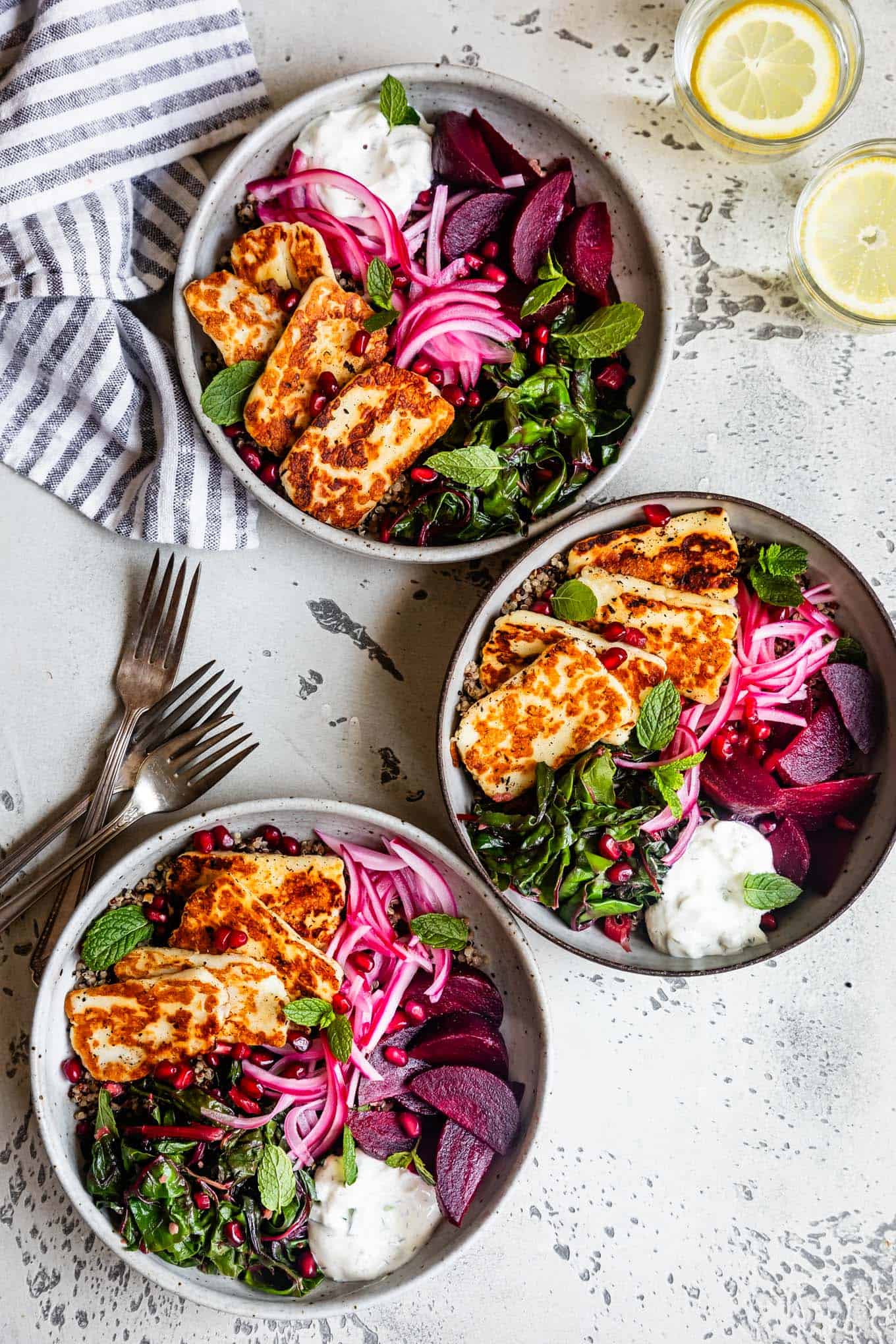
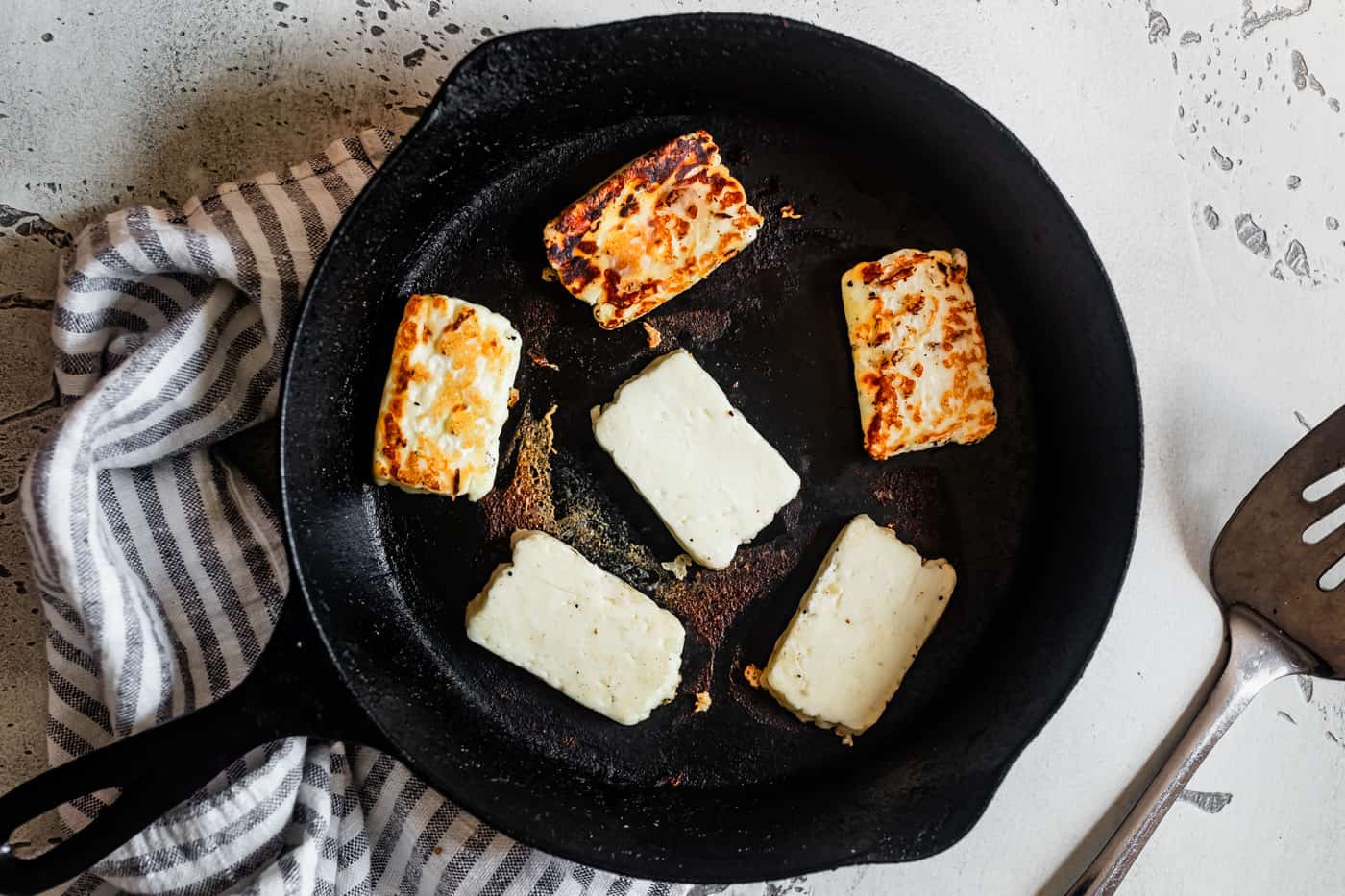
Halloumi FAQ
How to cook halloumi?
When cooked over medium to high heat, halloumi browns and crisps on the outside, leaving the inside soft, squeaky, and chewy. Unlike other cheeses, it doesn't melt, making it ideal for frying or grilling.
Fried halloumi cheese: Halloumi is super quick and easy to fry on the stove. Heat a non-stick or cast-iron skillet over medium-high heat, then add sliced halloumi in a single layer. You may notice a bit of liquid in the pan, and if so, let it evaporate so the bottom can get golden brown and crisp, about 2-3 minutes. Use a thin metal spatula or tongs to flip and cook on the other side for 1-2 minutes, until golden brown. Serve immediately. This is my go-to method for cooking halloumi cheese.
Grilled halloumi. Halloumi also makes an amazing grilling cheese. Add slices straight to the grill or carefully thread cubes onto a skewer with other ingredients. Grill until lightly charred, 1-2 minutes per side.
How many calories are in halloumi cheese?
Halloumi has about 90 calories per ounce. In this recipe, each person is served 2 ounces, so the halloumi accounts for 180 calories of the meal (about the same as 4 ounces of chicken thigh).
Can you store fried halloumi?
While halloumi is best served freshly fried, you can effectively store leftovers in an airtight container in the fridge. A quick 30-45 seconds in the microwave to warm it up will soften it up. While reheating sacrifices some of the crispiness, the cheese is still super delicious. While I've not tried it, I'm certain you could also reheat it in the air fryer for a couple of minutes to retain some of the crispy bits!
How else to serve halloumi?
Halloumi makes a great protein sub for most dishes. We use it in tacos with mango red pepper salsa, guacamole, and cabbage slaw, over burrito bowls with black beans and other toppings, or on skewers over salads. For more inspiration, check out the variety halloumi recipes from my friend Erin of Naturally Ella!

Tips for fried halloumi
If you're new to trying are a few tips to ensure you get perfectly golden brown halloumi with a soft chewy center, with none of that stuck-to-the-pan nonsense.
Use a cast-iron or non-stick skillet
The best way to ensure perfectly cooked halloumi that doesn't stick to the pan is to use a cast-iron or a non-stick skillet. As soon as the brown crust forms, the halloumi should release from the skillet easily. If you only have stainless steel skillets, drizzle a thin layer of oil to the preheated pan before adding the halloumi slices.
Make sure the skillet is hot before adding cheese
To ensure the cheese does not stick to the pan, leaving behind all that crispy fried cheese goodness, heat the pan up before adding the halloumi. A hot pan will create a crust on the cheese, so it slides right off the pan. To check if your pan is hot enough, a drop of water should sizzle in the pan.
Don't overcrowd the pan, but cook in batches
You might be tempted to fit as many halloumi slices in your skillet as possible, but resist that urge! Halloumi cooks quickly and goes from perfectly golden brown to burnt very fast. With too many slices, you may struggle to flip them all over at the same time. Instead, cook it in smaller batches. Don't worry, it cooks super quickly!
The second side browns quicker
It may take 2-3 minutes for the first side to release any moisture and crisp up perfectly golden brown all over, but when you flip it to the second side, the moisture has already been evaporated, so it'll brown up much quicker. Keep a close eye on it as soon as you flip it to the second side.
Fry halloumi last, just before serving
Halloumi is best eaten shortly after it's been cooked. This is when the outside is still crisp while the inside is chewy and soft. As it cools, the cheese gets firmer, and after 8-10 minutes, the texture will get a bit more rubbery and squeaky.
If that happens, don't worry, you can always give it a quick zap in the microwave to warm it up again. The outside will lose the crispiness, but the cheese is still super delicious. In fact, that's exactly how my family ate these bowls after I spent longer than 10 minutes taking pictures.
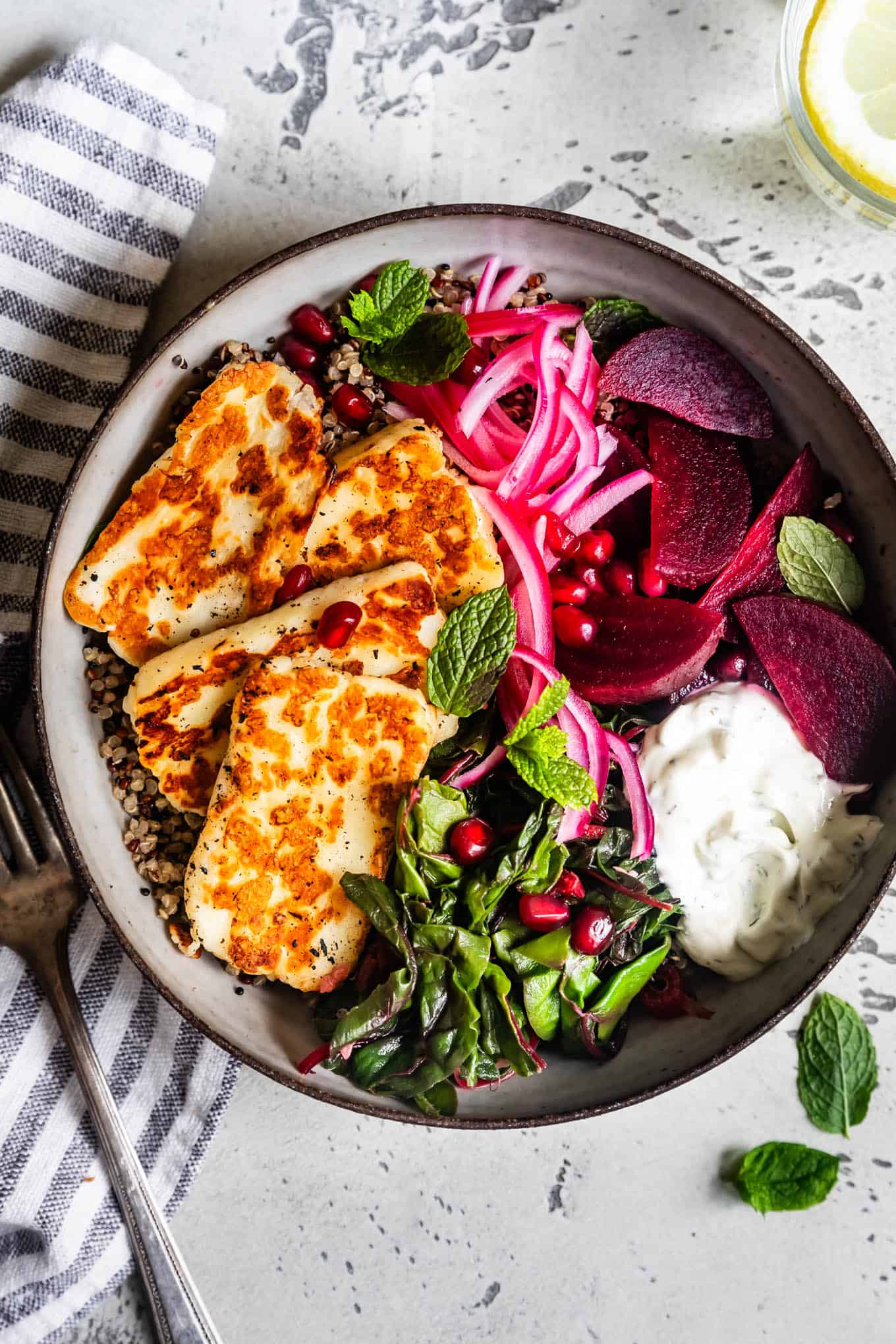

More Weeknight Dinner Recipes
- Moroccan-inspired summer vegetable tagine
- Vegetarian Shawarma Tacos (also makes a great bowl over brown rice!)
- Healthy Instant Pot Bolognese
- Gluten-Free Baja Fish Tacos
- Parmesan Roasted Cauliflower and Chicken Sheet Pan Dinner
Recipe
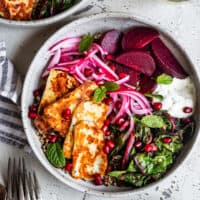
Fried Halloumi over Quinoa Veggie Bowls
Ingredients
- 1 teaspoon extra virgin olive oil
- 4 cloves garlic, thinly sliced or pressed
- 1½ cups quinoa, rinsed (white, red, or tri-colored)
- 1½ cups vegetable broth, I use bouillon cubes
- 1 teaspoon ground sumac, see note for substitution
- Juice of 1 lemon
- ⅓ cup hot water
- 1 teaspoon kosher salt
- 1 teaspoon granulated sugar
- ⅓ cup white wine vinegar, see notes
- 1 small red onion, halved and thinly sliced
- 1 teaspoon extra virgin olive oil
- 2 cloves garlic, pressed
- 1 large bunch rainbow chard or lacinato kale, torn from stems and ripped into bite-sized pieces. Discard stems or finely chop them separately.
- ¼ teaspoon kosher salt
- 8.8 ounces halloumi, cut into scant ¼-inch thick slices
- 8 ounces cooked peeled beets, cut into wedges and heated in the microwave or in a skillet, if desired (such as Love Beets)
- ½ cup tzatziki, pre-made such as Boar's Head Tzatziki Greek Yogurt Dip, or make your own - see notes below for quick recipe
- Optional for garnish: ¼ cup pomegranate arils
- Optional for garnish: Fresh mint leaves
INSTRUCTIONS
- Cook the quinoa. Heat a medium saucepan over medium heat or an instant pot on sauté function. Add olive oil and garlic, and cook, tossing, for 1 minute until lightly golden brown. Stir in quinoa, vegetable broth, and sumac. If using an instant pot, cover and pressure cook on high for 4 minutes and allow to naturally release for 10 minutes. Over stovetop, bring to boil, then reduce heat to low and simmer, covered, until the broth has been absorbed, 15-20 minutes. Remove from heat and let rest for 5 minutes. Add lemon juice and fluff with a fork.
- Make the quick pickled red onions. Pour the hot water over the sugar and salt in a medium jar. Stir to dissolve. Add the vinegar then nestle in the red onion slices. Let sit until ready to serve. The pickles will get even stronger as they sit and will last a couple of months in the fridge.
- Cook the chard. Heat a large cast-iron or non-stick skillet over medium heat. Add olive oil and garlic and cook, stirring, 1 minute, until lightly golden brown. If using stems, add stems with 1 tablespoon water and cook, stirring, until softened, 1-2 minutes. Add ripped chard leaves and salt, and cook, tossing, until wilted. Taste and add more salt, if desired. Transfer to a bowl and wipe out the pan.
- When ready to serve, fry the halloumi. Heat the same large skillet over medium-high heat. Once hot, add the halloumi slices in a single layer, cooking in batches if needed. Cook 1-2 minutes, until golden brown. Use a thin metal spatula to flip the halloumi and cook on the other side until golden brown, about 30 seconds to 1 minute. Transfer to a plate and repeat with the remaining slices.
- Build the bowls: Divide the quinoa among four bowls then top with pickled red onion, cooked chard, fried halloumi, and beets. Garnish with a couple tablespoons of tzatziki, and, if using, pomegranate arils and fresh mint leaves. Serve immediately.
Notes
Nutrition


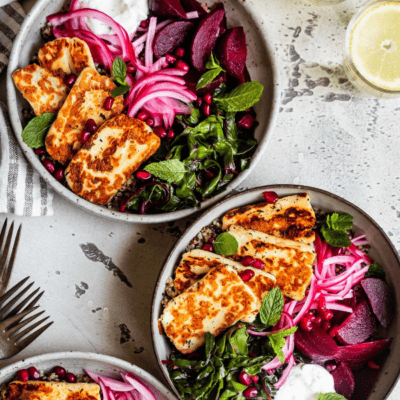
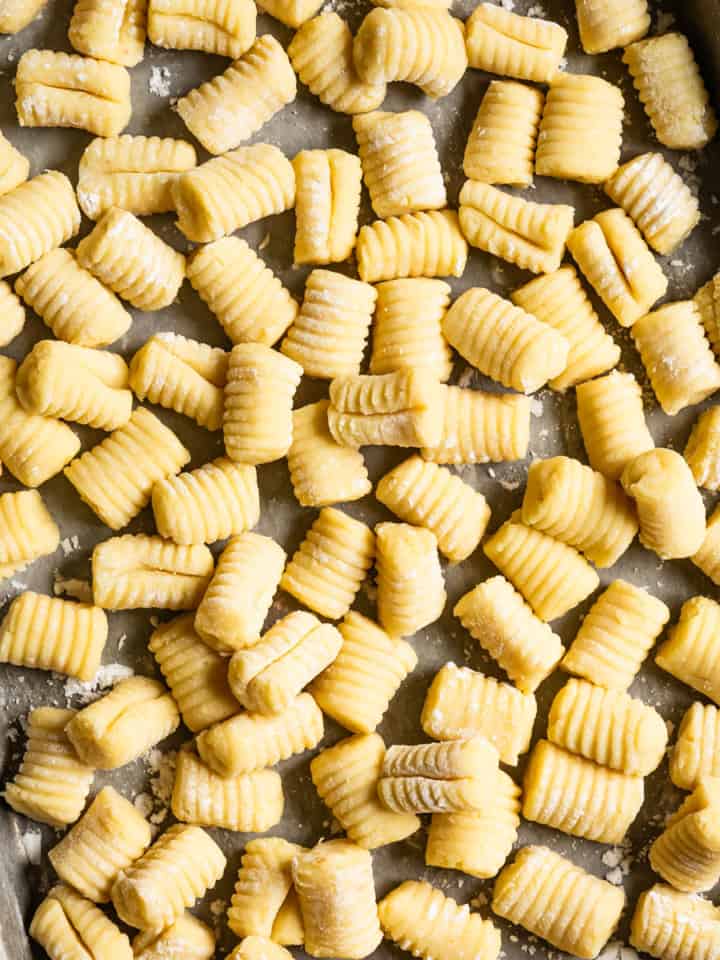
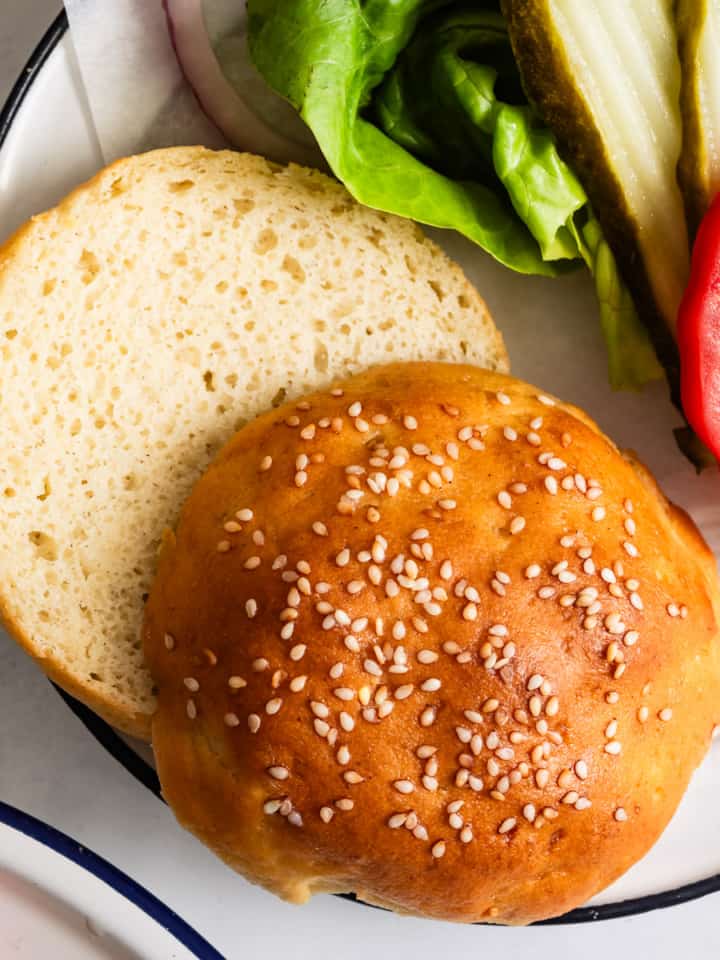







Lucie -
Great idea to use halloumi in bowls. And beautiful photos!